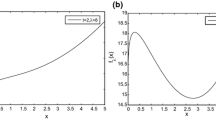Abstract
In this work we determine the normal solution of the finite moment problem in three different Hilbert space settings, both in the absence and in the presence of noisy data. In two cases the normal solution is a polynomial while in the third it is not. However, in each case the normal solution is spanned by orthogonal functions that are obtained by computationally efficient algorithms. A criterion of “a posteriori validation”, to select that normal solution which minimizes the uniform norm of the recovery error, is also given. The effectiveness of the method is illustrated with a number of test functions, for the most part already proposed in the literature.
Similar content being viewed by others
References
R. Askey, I.J. Schoenberg and A. Sharma, Hausdorff' s moment problem and expansions in Legendre polynomials, J. Math. Anal. Appl. 86 (1982) 237–245.
R.E. Bellman, R.E. Kalaba and J.A. Lockett,Numerical Inversion of the Laplace Transform (Elsevier, New York, 1966).
A. Björk, Solving linear least square problems by Gram-Schmidt ortogonalization, BIT 7 (1967) 1–21.
P. Craven and G. Wahba, Smoothing noisy data with spline functions: estimating the correct degree of smoothing by the method of Generalized Cross Validation, Numer. Math. 31 (1979) 377–403.
Ch.W. Groetsch,The Theory of Tikhonov Regularization for Fredholm Equations of the First Kind, vol. 10 of Research Notes in Mathematics (Pitman, London, 1984).
F. Hausdorff, Moment Probleme für ein endliches Intervall, Math. Z. 16 (1923) 220–248.
A. Iserles, P.E. Koch, S.P. Nørsett and J.M. Sanz-Serna, Orthogonality and approximation in a Sobolev space, in:Algorithms for Approximation II, eds. J.C. Mason and M.G. Cox (Chapman and Hall, 1990).
J.W. Longley,Least Squares Computation Using Orthogonalization Methods, vol. 93 of Lecture Notes in Pure and Applied Mathematics (M. Dekker, New York and Basel, 1984).
The MathWorks Inc., South Natick, MA,MATLAB-386 Version 3.5e (1989).
G. Rodriguez and S. Seatzu, Numerical solution of the finite moment problem in a reproducing kernel Hilbert space, J. Comp. Appl. Math. 33 (1990) 233–244.
G. Rodriguez and S. Seatzu, On the solution of the finite moment problem, J. Math. Anal. Appl. 171 (1992) 321–333.
G. Rodriguez and S. Seatzu, On the numerical inversion of the Laplace transform in reproducing kernel Hilbert space, IMA J. Numer. Anal. 13 (1993) 463–475.
I.J. Schoenberg, Remarks concerning a numerical inversion of the Laplace transform due to Bellman, Kalaba and Lockett, J. Math. Anal. Appl. 43 (1973) 823–838.
G. Talenti, Recovering a function from a finite number of moments, Inverse Problems 3 (1987) 501–517.
A.N. Tikhonov and V.Y. Arsenin,Solution of Ill-Posed Problems (Wiley, 1977).
G. Wahba, Smoothing and ill-posed problems, in:Solution Methods for Integral Equations with Applications, ed. M. Goldberg (Plenum Press, New York, 1979).
K. Yosida,Functional Analysis (Springer, Berlin, 1978).
Author information
Authors and Affiliations
Rights and permissions
About this article
Cite this article
Rodriguez, G., Seatzu, S. Approximation methods for the finite moment problem. Numer Algor 5, 391–405 (1993). https://doi.org/10.1007/BF02109420
Issue Date:
DOI: https://doi.org/10.1007/BF02109420




